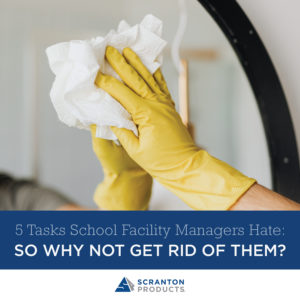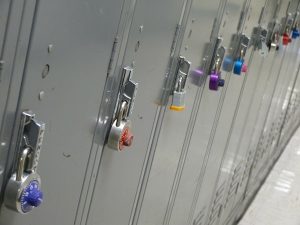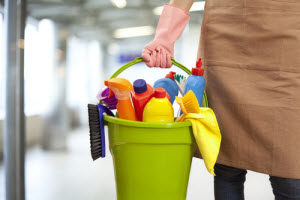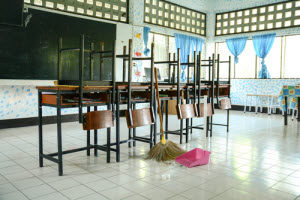 As a facility manager in charge of an entire school, there are probably a bunch of tasks that you’re not a fan of. In fact, you may even loathe them, so why not find a way to get rid of them? One of the most common tasks that has caused considerable dislike is routine locker maintenance. Given the number of lockers in your school, and the variety of issues that can occur with them, facility managers simply hate the meticulous nature of maintaining them. However, because it’s a school, you can’t simply get rid of the lockers and have barren hallways. Students need storage compartments for their books and supplies, but there has to be a better alternative that can reduce your workload.
As a facility manager in charge of an entire school, there are probably a bunch of tasks that you’re not a fan of. In fact, you may even loathe them, so why not find a way to get rid of them? One of the most common tasks that has caused considerable dislike is routine locker maintenance. Given the number of lockers in your school, and the variety of issues that can occur with them, facility managers simply hate the meticulous nature of maintaining them. However, because it’s a school, you can’t simply get rid of the lockers and have barren hallways. Students need storage compartments for their books and supplies, but there has to be a better alternative that can reduce your workload.
The 5 Tasks of Locker Maintenance That Facility Managers Despise
- Painting. Giving all of your lockers a fresh coat of paint is never fun. Sometimes, though, there are no other options. Whether the exterior is chipping, or there’s considerable wear and tear, you can’t get away with painting just one locker. Still, while you’re carefully brushing the paint on, you may also dislike the fact that it’s filling your school with harmful VOC emissions.
- Graffiti Removal. It’s hard not to take graffiti personally since it’s you that has to clean it off the locker. This requires more repainting, which simply adds to the frustration because you know it can, and probably will, happen again.
- Removing Rust. Facility managers hate rust removal because it’s so tedious. Whether you’re using vinegar or baking soda, endlessly scrubbing one specific spot on a locker is an easy way to wear your wrist out, let alone drive you crazy.
- Meticulous Cleaning. In order to prevent signs of rust, unsightly stains, or dust, the lockers require significant cleaning. Power washing makes the process a lot easier, but even that results in considerable cleanup, and you have to wait until students are out of the building.
- Replacing Lockers. When they can’t take any more, lockers need to be replaced. They get slammed shut every day and they’re exposed to the elements. However, replacing them can result in high costs and painstaking installation.
Getting Rid of These Menial Tasks
If you’ve always fantasized about ways to rid yourself of these meticulous, dull, yet important tasks, there are actually ways to get around them while still having viable lockers and storage compartments for students. HDPE plastic has been introduced to schools across the country, and has met with positive results among students and facility managers. These lockers have successfully cut down on routine maintenance. HDPE is a solid plastic, so it has a durable structure that’s actually resistant to impacts, scratches, and rust. When there’s graffiti present, you don’t have to open a fresh can of paint. The graffiti can simply be wiped off the locker without affecting the locker’s homogenous color. You’ll save time and money on maintenance with HDPE lockers. They’ll provide the necessary storage for students while ridding your day of those pesky tasks. Finding ways to cut your maintenance costs is great, but finding a way to eliminate the task altogether is every facility manager’s dream. Implementing HDPE plastic into your school will reduce the time and money that goes into your school’s maintenance. That way you’ll have a long lasting material that doesn’t require any frustrating or meticulous maintenance, allowing you to use your time towards more important and pressing tasks in your school. Want to learn more about HDPE lockers and the benefits of choosing them for your school? Download this eBook, The Ultimate Guide to HDPE Plastic Lockers, from your friends at Scranton Products.

 Now that you’ve got your time to paint, you need your place. Find an open area in the school that you can paint. It will allow you to have the room to paint multiple lockers, so you can start getting the job done. That way, you can reinstall the lockers quickly. You can paint the lockers where they stand, but you’ll need plenty of tarp or drop cloth coverage to prevent any paint from getting on the floor or the wall.
Now that you’ve got your time to paint, you need your place. Find an open area in the school that you can paint. It will allow you to have the room to paint multiple lockers, so you can start getting the job done. That way, you can reinstall the lockers quickly. You can paint the lockers where they stand, but you’ll need plenty of tarp or drop cloth coverage to prevent any paint from getting on the floor or the wall. Metal lockers are very durable and reliable storage compartments for the students. Sometimes, though, their maintenance, care, and upkeep outweigh their usefulness compared to plastic lockers. The constant maintenance and repainting certainly adds to the locker’s costs. What you need is a reliable locker that doesn’t require the constant upkeep while retaining its appearance and durability.
Metal lockers are very durable and reliable storage compartments for the students. Sometimes, though, their maintenance, care, and upkeep outweigh their usefulness compared to plastic lockers. The constant maintenance and repainting certainly adds to the locker’s costs. What you need is a reliable locker that doesn’t require the constant upkeep while retaining its appearance and durability.
 It’s important to give your hallways a thorough cleaning before the school year begins. Most germs and bacteria are picked up through foot traffic, and more often than not, those germs end up in the hallways. Utilizing a strong disinfectant cleaner can help combat the spread of germs. However, there are green cleaning products on the market that can help you achieve germ removal and still keep harmful chemicals from contaminating the air.
It’s important to give your hallways a thorough cleaning before the school year begins. Most germs and bacteria are picked up through foot traffic, and more often than not, those germs end up in the hallways. Utilizing a strong disinfectant cleaner can help combat the spread of germs. However, there are green cleaning products on the market that can help you achieve germ removal and still keep harmful chemicals from contaminating the air. Be sure to check your air and water quality to see if it’s up to code. Find a water tester in the area to help you conduct these routine tests so you can see where the quality lies. If the result isn’t as high as you’d hoped, consider replacing the filtration system. When it comes to air, there are several ways that you can do your part increase the quality. Consider getting indoor plants, utilize
Be sure to check your air and water quality to see if it’s up to code. Find a water tester in the area to help you conduct these routine tests so you can see where the quality lies. If the result isn’t as high as you’d hoped, consider replacing the filtration system. When it comes to air, there are several ways that you can do your part increase the quality. Consider getting indoor plants, utilize